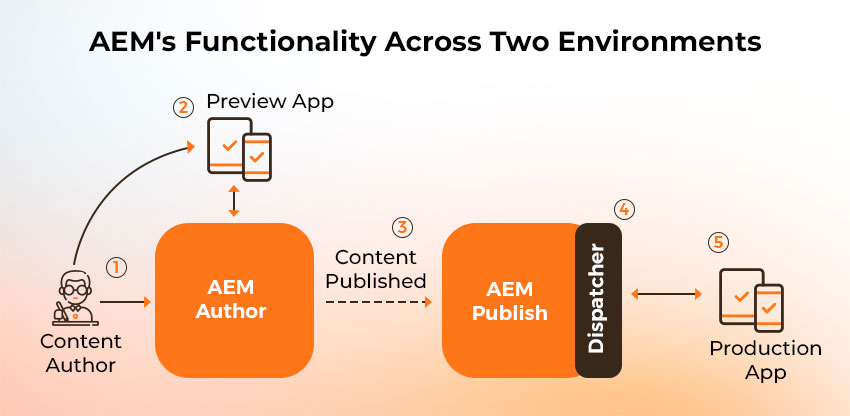A powerful content management system that simplifies digital content management in author and publisher environments is Adobe Experience Manager (AEM). It ensures that only authorized, optimized content is published on the live site, allowing authors to concentrate on producing high-quality content. The creation and publishing processes are separated. This blog post examines how AEM helps companies optimize content workflows, uphold brand consistency, and provide customers with exceptional digital experiences. It does this by emphasizing important capabilities and providing case studies of companies using this potent CMS.
Understanding What AEM is?
Adobe Experience Manager, in its strategic component, is a content management system that includes multiple features and offers businesses to control content and channel over digital channels. AEM makes the management of different content assets, including papers, photos, videos, and forms, more accessible. It performs exceptionally well in digital asset management, guaranteeing effective asset access and utilization from any location.
Because Adobe Experience Manager Services is built on top of Adobe Cloud technology, content creation, publication, and delivery can be done with ease. This gives users the flexibility to develop websites, interact with them, and start blogs with lots of information. Currently, 34,990 live websites are using Adobe Experience Manager with an emphasis on digital asset management; AEM uses immersive and personalized digital interactions to accelerate corporate growth, improve user experiences, and streamline operations.
Components of AEM
The following are the AEM components:
| Component Name | Description |
| Page | One type of resource which is needed in content management and represents the contents of a webpage |
| Paragraph System | It handles paragraphs that organize actual components that carry the content. |
| Core Components | Standardized Web Content Management Components in AEM. It helps to improve development efficiency and minimize maintenance costs. |
| Template Components | Basic building blocks/bricks for pages, giving them flexibility and rich authoring functions. |
| Page Authoring Components | Components assisting users in creating/editing pages, making page creation easy and quick. |
| Container Components | They are used to create containers that can hold other components or structured content. |
| Form Components | These components are used to build forms on AEM site pages. |
| Email Core Components | Components built on Core Components for use with Adobe Campaign. They allow the integration of email marketing capabilities. |
What are the Features of AEM?
Adobe Experience Manager (AEM) is a rich in features Content Management System (CMS) tool that helps companies to develop, control, and disperse custom-made digital experiences at multiple platforms be it a desktop or a smartphone. The following are some essential Adobe Experience Manager capabilities that support the use of AEM best practices:
Content Authoring: With capabilities like Content Fragments, In-context Editing, Style and Design choices, Auto-Text Summarization, and Out-of-the-Box Components, AEM authoring enables users to produce and manage content effectively.
Digital Asset Management: Businesses can develop engaging shopping experiences across many channels, link with campaign dashboards, marketing tools, and commerce data, and manage digital assets effectively with AEM.
Forms and Cloud Services from AEM: AEM offers templates, form creation tools, and automated form conversion. It also provides security, scalability, and updated services through Adobe Commerce Cloud.
Integration with Other Adobe Solutions: To improve teamwork, optimize processes, customize online content, and monitor results, AEM easily interfaces with other Adobe solutions such as Adobe Workfront, Creative Cloud, Target, and Analytics Cloud.
Dynamic Media Delivery: AEM helps manage and publish dynamic digital experiences across a range of devices, facilitating the regular customization and delivery of multimedia content.
Automated Forms Conversion: With the help of the AEM Forms feature, outdated PDF forms may be automatically converted into digital, mobile-responsive, adaptive forms that improve AEM user experience and integration with themes and analytics.
Improved Collaboration and Efficiency: With its unified platform for content production and administration, AEM streamlines processes, boosts productivity, and allows content to be published across many channels and personalized for improved consumer engagement.
Benefits of AEM Content Authoring
Content creators also get good news from Adobe, which is the Experience Manager (AEM) provider, a full-service Content Management System (CMS). Writers can work faster and smarter as a result of developing websites built on the back of a complete set of features and a user-friendly interface of AEM. The following are some significant benefits of content authoring with AEM:
Ease of Use
One of AEM’s advantages is that it has a friendly user interface. Users can, therefore, easily use its interface to produce content with the model. The WYSIWYG (What You See Is What You Get) editor permits authors to check and adjust the text in real time, which helps to cut the learning relationships and raise productivity. Despite the users’ lack of technical knowledge, AEM’s drag-and-drop feature and easy-to-use styles allow them to organize and align materials even with no effort.
Increased efficiency
The content authoring tools in AEM are designed to be time—and effort-efficient. Authors can communicate rapidly by creating, modifying, and publishing their content by using content templates, version management, and in-line editing. AEM is an agile medium that can handle many content types on a single platform, such as text, photos, and videos. That means that the content development process is simplified by interpolating many applications.
Improved Consistency
Maintaining consistent branding and messaging across many media might be challenging. Still, authors can accomplish this with the aid of AEM. AEM’s templates and components guarantee that content follows preset styles and guidelines, creating a unified brand identity. Content authors may implement standardized formatting, styles, and metadata effortlessly, guaranteeing that their work conforms to the organization’s guidelines.
Collaboration
AEM makes it easier for stakeholders, editors, and content creators to collaborate smoothly. The workflow management system integrated within the platform enables authors to review content, assign tasks, and give real-time feedback. Multiple authors can work on the same piece of content at once with AEM’s version control features, which lowers the possibility of conflicts and guarantees that everyone is working with the most recent version of the material.
Omnichannel Content Management
In this digital age, the content must be distributed across various platforms like social media, mobile applications, and websites. Using Adobe Experience Manager’s omnichannel content management capabilities, author content can be launched and managed very quickly on different platforms, and it can be adjusted and provided to multiple users. This is aimed at making the experience similar regardless of the device or channel used by a customer at the same time.
Integrations
AEM can be very smoothly integrated with other Adobe products, such as Adobe Analytics for data analysis and Adobe Marketing for e-commerce features. These connectors enable authors to collect and manage information from one place, thereby saving their time and simplifying the process of switching between tools. Furthermore, the web app’s interaction with other systems, such as marketing automation tools and CRM platforms, adds to its flexibility and feature profile.
AEM Works Through Two Environments
The Author Environment and the Publish Environment are the two primary environments that Adobe Experience Manager (AEM) uses to function. These settings ensure a smooth workflow for marketers, editors, and content authors by playing different but related roles in the content generation and distribution process within AEM.

Author Environment:
The center for managing and creating content in AEM is the Author Environment. With its intuitive interface, users can create, modify, and customize website material without requiring high technical knowledge. The Author Environment has the following main features:
- Functionality: Adobe Experience Manager (AEM) has an Author Environment offering content creation, editing, and organizing features. It has capabilities like version control, workflows, WYSIWYG editing, drag-and-drop components, customizable workspaces, and collaboration tools to optimize the content creation process effectively.
- User Interface:
- Customizable Workspace: Productivity is increased by users’ ability to customize the interface to fit their tastes and workflows.
- Navigation: Navigating across the platform’s various sections is made simple by its intuitive navigation features.
- Search: Robust search capabilities let users find assets and material in the system quickly.
- Content Creation Tools:
- Drag-and-Drop Components: Persons can rapidly fix a web page and replace elements without using standard design and development tools.
- WYSIWYG Editing: WYSIWYG editing, which means what you see is what you get, will allow you to edit the already available content with just a few clicks.
- Component Configuration: Users can alter components to satisfy particular functional and design specifications.
- Template Management: This process expedites the generation of content by offering pre-made templates with standardized design and layout.
- Rich Text Editor: This tool lets users add media, format text, and produce interesting content.
- Asset Management: Asset management is the process of organizing and keeping track of digital assets including papers, films, and photos in one central location.
- Collaboration Features:
- Version control: Users can revert to previous versions in case of mistakes and see changes.
- Workflows: This software optimizes the reviewing and approving process while explaining content publishing protocols.
- Annotations and Comments: Annotations and comments facilitate collaborative working on a content piece as well as feedback provision.
Publication Environment:
The aim of the Publish environment within AEM is to deliver highly accurate, dependable, brand-confirming information to its target audience. Adobe Commerce Partners do understand and optimize well this environment for smooth content delivery and better user experiences.
- Functionality: The main objective of the AEM Publish Environment is to deliver finished content to the audience. Thus, this move ensures data integrity, accuracy, and brand compliance.
- Purpose: A primary goal of the Publish Environment is to provide content seekers with a stable means of retrieving the latest content without obstacles or variations. It is the beginning and the end of a user’s interaction with the website.
- Content Delivery: The AEM publish Environment provides consumers with content effectively, guaranteeing they get the most recent information and updates in real time. The expedited delivery procedure improves user satisfaction and engagement.
- Security: One of the main priorities in the AEM Publish Environment is security. Strong security measures guarantee data integrity and prevent unwanted access to the transmitted content. AEM analytics are essential for monitoring and improving security protocols for better user experiences.
- Content Updates: The publish environment makes it easier to update information smoothly without affecting the user experience. It enables scheduled publication, version control, and real-time content updates to keep the website current and relevant.
Real-life Example
AEM is used by Hurix, a digital content management company that optimizes and manages its digital content. In its complex architecture, there are several author and publisher instances. AEM is employed by Hurix’s content builders in the author environment to create, edit, and manage the digital material.
This process reduces errors and enhances output quality by submitting the materials for examination and approval before they go live. Similar to this system, it has resulted in a 42 percent performance improvement among the company’s IT infrastructure teams.
Conclusion
Adobe Experience Manager (AEM) is an integral part of improving business operations because it facilitates efficient content management and delivery across multiple channels. It can be integrated with Adobe’s e-commerce platform, Adobe Commerce, especially Adobe B2B Commerce, allowing companies to create seamless omnichannel experiences that are adaptable to various customer requirements. These provisions enable businesses to manage their electronic resources and material through AEM, like personalizing contents or workflows on top of scalability. This will eventually lead to more sales revenue growth with increased satisfaction levels from consumers.
Read more: Adobe Commerce App Builder and Its Modern Techniques
FAQs
With capabilities like content fragments, inline editing, and drag-and-drop flexibility, AEM content authoring delivers benefits, including expedited content production, improved collaboration, and tailored experiences.
With AEM writing, you can create a variety of content types that are easily reusable across various channels and devices, including text summaries, content fragments, and structured content models.
Components are modular blocks in AEM authoring that actualize particular capabilities to deliver content on a website. They play a crucial role in the content production process since they are reusable, self-contained, and capable of containing additional components.
Yes, developers can customize and extend default functionality by modifying AEM components using HTL (preferred) or JSP.
AEM provides tools like workflows and review procedures to guarantee the correctness and quality of the material. These procedures allow multiple users to collaborate on content, promoting consistency and teamwork.
For further details on the AEM content editing procedure, consult the official Adobe Experience Manager literature. It offers comprehensive instructions and tutorials for content production in AEM.
To monitor writing activities, such as content modifications, user actions, and user comments, AEM offers auditing and analytics tools. This enhances the authoring process and helps pinpoint areas that need work.
Related Articles
-
The Best eCommerce Security Tips And Practices In 2023
The security of their user’s data has to be the most crucial aspect of running the business for an eCommerce business owner. Besides, why not? Attack patterns over the past
-
Step-by-Step Guide to Implementing Adobe Analytics in AEM
Summary: In the world of data, where everything speaks digital, the fusion of such powerful tools can make a difference. Imagine now a Swiss Army knife for digital marketing; that’s
-
Magento 2: The Top Ten New Exciting Features
In our past blogs, we had already discussed how Magento Ecommerce Development can benefit our business and how to install Magento 2. Now, in this article, we will take a




